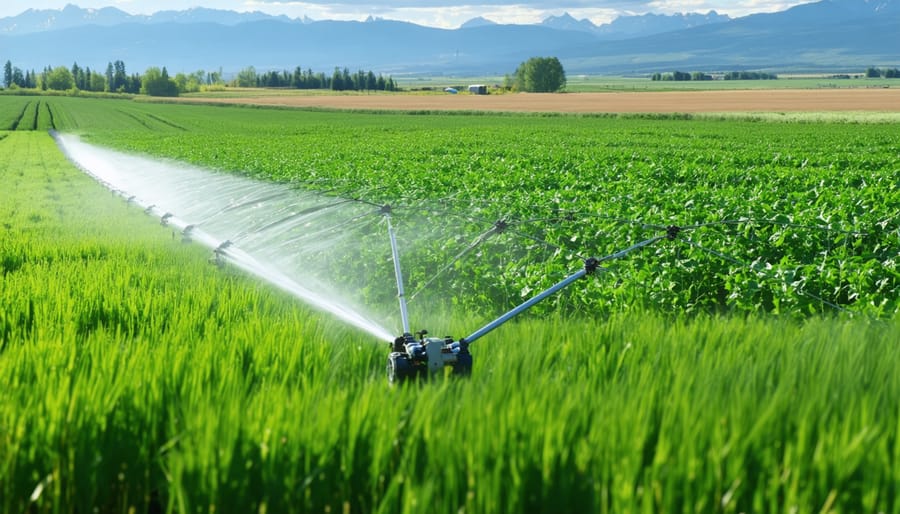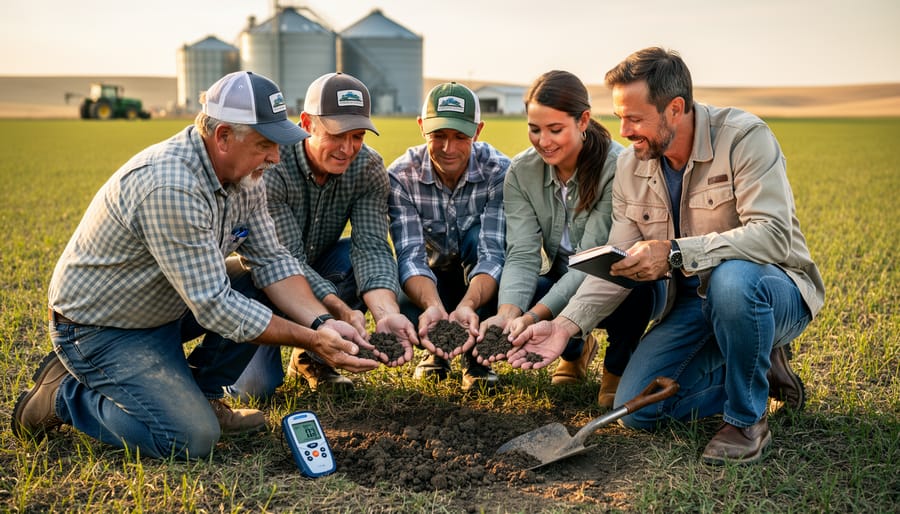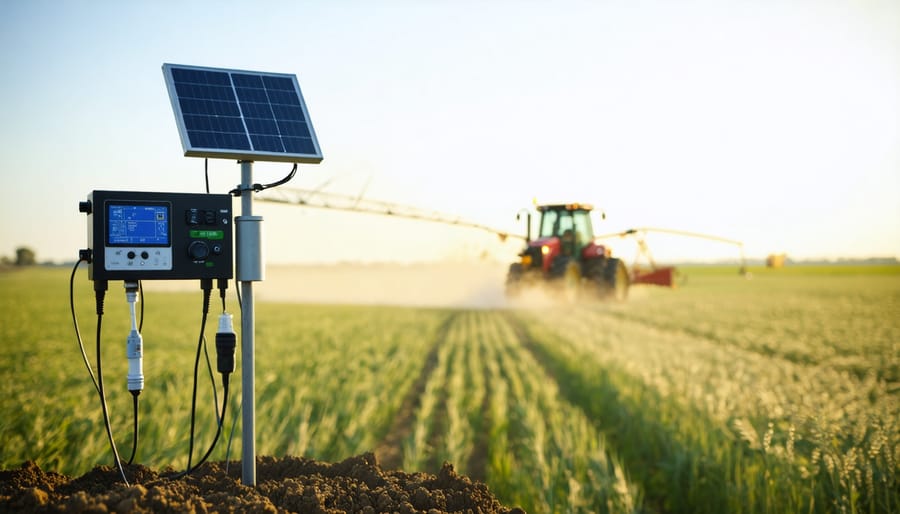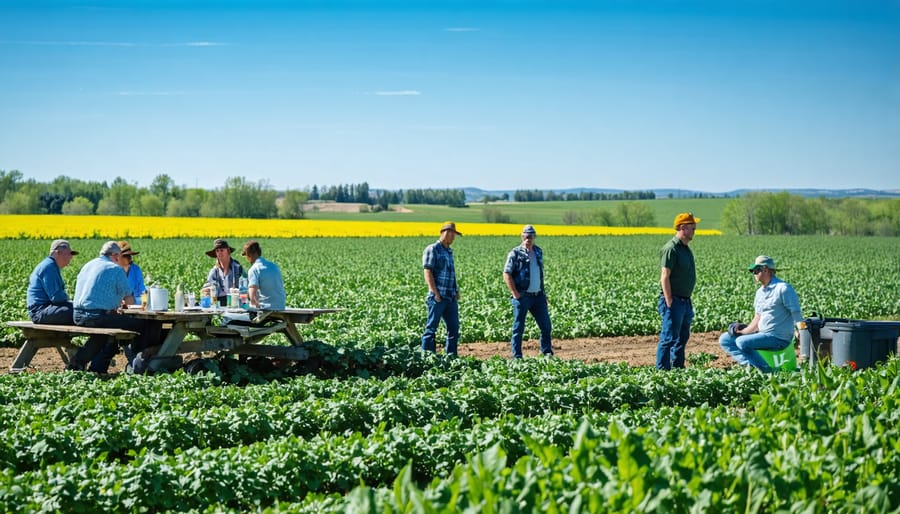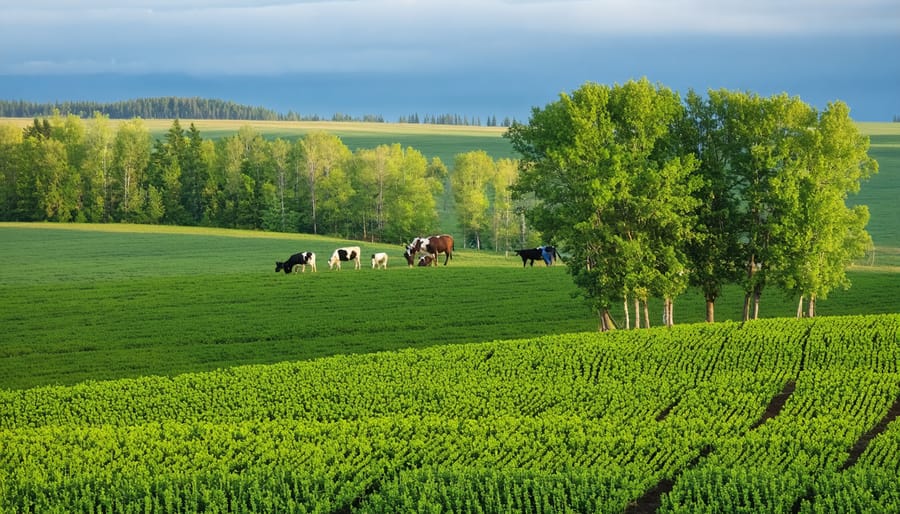Transform agricultural landscapes through precision irrigation systems that reduce water usage by 30-40% while maximizing crop yields. Implement diverse crop rotations with nitrogen-fixing legumes to naturally enrich soil nutrients and combat climate change through sustainable practices. Integrate advanced soil monitoring technologies to maintain optimal moisture levels and nutrient balance across Alberta’s varied terrain.
Modern agronomy stands at the intersection of environmental stewardship and food security, demanding innovative solutions that work with nature rather than against it. Canadian farmers are pioneering regenerative techniques that boost productivity while preserving vital resources for future generations. From the fertile Black Soil Zones of central Alberta to the semi-arid regions of the south, sustainable agronomic practices are reshaping how we approach food production.
Through careful management of soil health, water resources, and biodiversity, Alberta’s agricultural community is demonstrating that economic viability and environmental sustainability can coexist. These proven methods not only enhance farm resilience but also ensure long-term food security for our growing population.
Water-Smart Farming: The Alberta Advantage
Understanding Your Farm’s Water Profile
Understanding your farm’s water profile starts with a comprehensive assessment of your current water usage patterns. Begin by mapping out all water sources on your property, including wells, dugouts, and natural water bodies. Track your water consumption through detailed record-keeping, noting seasonal variations and peak usage periods.
Conduct regular soil moisture testing using both manual probes and modern soil sensors to understand water retention patterns across different fields. This data helps identify areas that may need additional attention or modified irrigation practices. Pay special attention to factors like soil type, topography, and crop requirements, as these significantly impact water management strategies.
Consider implementing water meters at key points in your irrigation system to measure usage accurately. Many Alberta farmers have found success using smart irrigation controllers that adjust water application based on real-time weather data and soil conditions. Document rainfall patterns and compare them with historical data to better predict future water needs.
Look for water loss points in your system, such as leaky irrigation lines or areas of excessive runoff. These observations will help prioritize improvements and guide investment in water-efficient technologies.
Local Climate Patterns and Water Planning
Alberta’s climate presents unique challenges for agricultural water management, with its distinct seasonal patterns and variable precipitation. The region typically experiences cold winters, warm summers, and an average annual rainfall of 300-500 millimetres, making water conservation crucial for sustainable farming.
Recent climate data shows increasing weather variability, with more frequent extreme events like drought and intense rainfall. Farmers across the province have adapted by implementing innovative water management strategies, including precision irrigation systems and soil moisture monitoring technologies.
Local weather patterns significantly influence planting dates and crop selection. Many Alberta farmers now use climate forecasting tools to make informed decisions about seeding times and crop rotation schedules. The adoption of drought-resistant crop varieties has become increasingly common, particularly in southern regions where moisture stress is more prevalent.
Successful water planning requires understanding these patterns and maintaining flexibility in management approaches. Many producers are working with local agricultural extension services to develop customized water management plans that account for their specific microclimates and soil conditions. This collaborative approach has proven effective in building resilience against climate uncertainties while maintaining productive and sustainable farming operations.
Practical Water Conservation Techniques
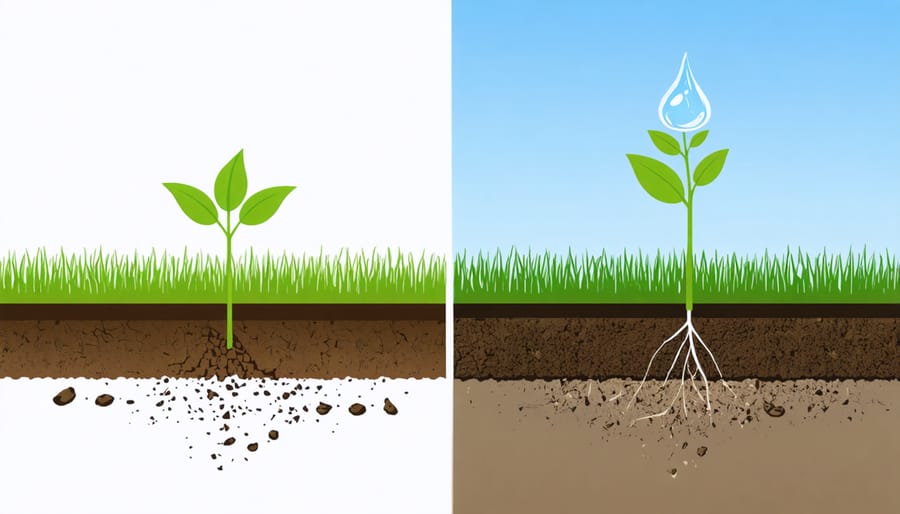
Soil Management for Better Water Retention
Effective soil management is crucial for water conservation in Alberta’s diverse agricultural landscape. By implementing strategic practices, farmers can significantly improve their soil’s water-holding capacity while promoting long-term sustainability.
Adding organic matter through crop residue management and cover cropping helps create a soil structure that retains moisture more effectively. Many Alberta farmers have found success by incorporating composted manure and green manure crops, which not only improve water retention but also enhance overall soil health.
Reducing tillage operations helps maintain soil structure and prevents moisture loss through evaporation. No-till or minimum-till practices protect valuable organic matter and create natural channels for water infiltration. These channels, formed by earthworms and root systems, allow water to penetrate deeper into the soil profile.
Soil testing is essential for understanding your land’s specific needs. Regular testing helps determine organic matter content and identifies areas requiring additional amendments. Many successful Alberta farmers conduct seasonal soil tests to track improvements and adjust their management strategies accordingly.
Consider implementing contour farming and terracing on sloped land to slow water movement and prevent erosion. These techniques have proven particularly effective in the rolling landscapes of central Alberta, where water management can be challenging.
For optimal results, combine these practices with proper crop rotation and strategic residue management. This integrated approach helps build resilient soils that can better withstand both drought and excessive moisture conditions, supporting sustainable agricultural production for years to come.
Smart Irrigation Systems That Pay For Themselves
Modern irrigation systems have evolved far beyond simple sprinklers, becoming intelligent water management solutions that offer significant returns on investment for Alberta farmers. By integrating digital farming technologies, these systems can reduce water usage by 30-50% while increasing crop yields by up to 25%.
Local farmer Mike Thompson from Lethbridge reported recovering his $45,000 investment in smart irrigation within two growing seasons through water savings and improved crop quality. His system uses soil moisture sensors, weather data, and automated controls to deliver precise amounts of water exactly when and where needed.
The cost-effectiveness of these systems comes from multiple benefits:
– Reduced water consumption and associated pumping costs
– Lower labour requirements through automation
– Decreased fertilizer leaching
– Improved crop quality and yield consistency
– Prevention of disease through optimal moisture management
Many Alberta farmers can access provincial grants covering up to 30% of installation costs through the Canadian Agricultural Partnership. The Alberta Irrigation Technology Centre demonstrates that farms using smart irrigation systems typically see complete ROI within 2-4 years, depending on crop type and field size.
For those starting out, simple soil moisture sensors and automated timers can provide immediate benefits while building toward a more comprehensive system. Local agricultural extension offices offer free consultations to help farmers determine the most cost-effective irrigation solutions for their specific needs.
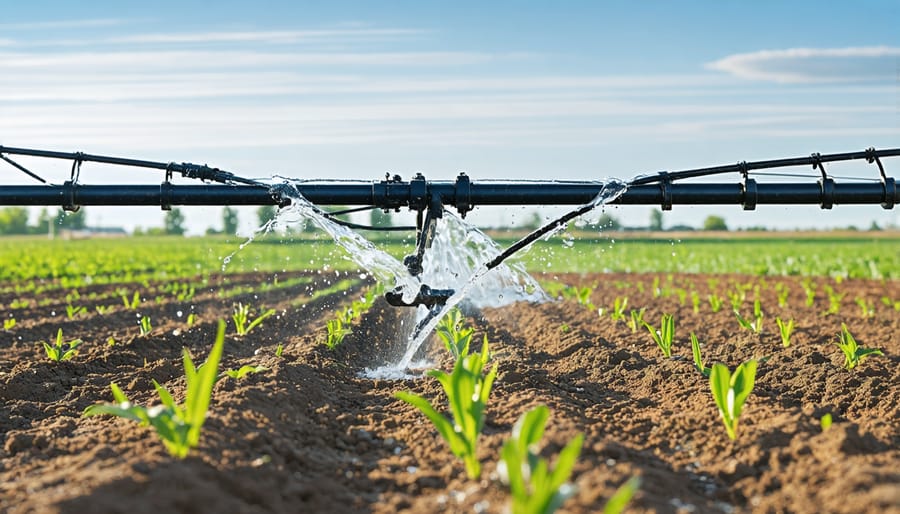
Water Recycling on Your Farm
Water recycling on your farm isn’t just environmentally responsible – it’s a smart business decision that can significantly reduce your water costs while maintaining crop yields. Here in Alberta, where water conservation is increasingly important, many farmers are discovering innovative ways to recycle and reuse water effectively.
A well-designed water recycling system typically includes collection points for rainwater and irrigation runoff, storage facilities, and filtration systems. Start by installing rain harvesting equipment on existing structures like barns and equipment sheds. A standard barn roof of 200 square metres can collect up to 150,000 litres of water annually in our climate.
Consider implementing a tailwater recovery system, which captures excess irrigation water for reuse. These systems have helped Alberta farmers reduce their water consumption by up to 30% while maintaining crop productivity. The Lethbridge Research Centre found that farms using these systems saved an average of $2,000 in water costs during the growing season.
Adding retention ponds strategically throughout your property can capture both rainfall and irrigation runoff. These ponds also serve as wildlife habitats, contributing to your farm’s biodiversity. Remember to include sediment traps and basic filtration systems to maintain water quality for reuse.
For greenhouse operations, condensation recovery systems can recapture up to 50% of water lost through plant transpiration. Several Red Deer area farmers have successfully integrated these systems, reporting significant water savings during winter greenhouse operations.
Real Results: Alberta Success Stories
The Thompson Family Farm Transformation
Located just outside of Lethbridge, the Thompson Family Farm’s journey towards sustainable water management showcases how traditional farming wisdom can blend with modern innovation. In 2019, Sarah and Mike Thompson inherited their 800-hectare farm from Sarah’s parents and faced significant water management challenges due to increasingly unpredictable rainfall patterns.
The Thompsons implemented a comprehensive water management system that included soil moisture monitoring sensors, precision irrigation technology, and drought-resistant crop rotation. They installed six strategically placed soil sensors across their property, providing real-time data through a mobile app. This allowed them to make informed decisions about irrigation timing and volume.
The results have been remarkable. Within two years, the farm reduced water consumption by 32% while maintaining crop yields. Their water efficiency improvements led to annual savings of approximately $15,000 in irrigation costs. The farm’s soil health has also improved significantly, with organic matter content increasing from 2.8% to 3.5%.
The Thompsons now share their experience with neighboring farms, hosting quarterly workshops to demonstrate their water management techniques. Their success story proves that sustainable water management isn’t just environmentally responsible – it’s economically beneficial for Alberta’s farming community.
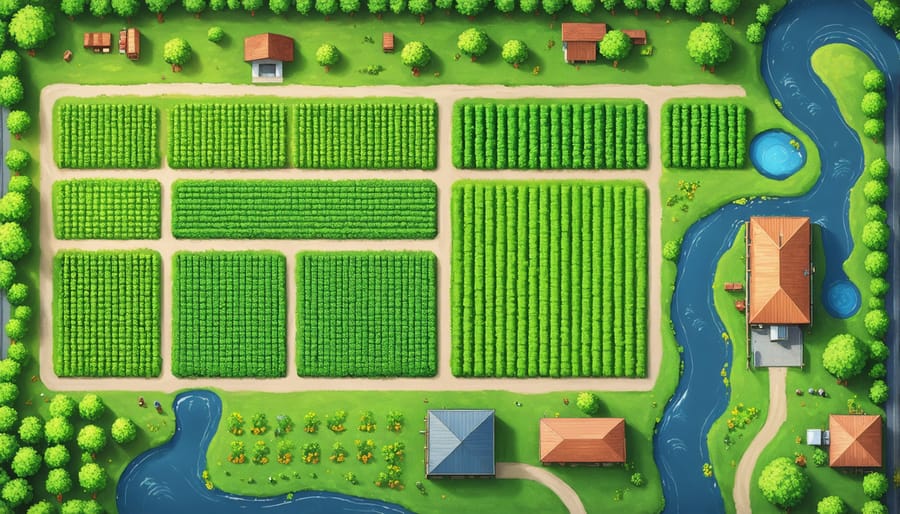
Community-Led Water Conservation Projects
In Alberta’s agricultural landscape, community-based agricultural initiatives are leading the way in sustainable water management. The Southern Alberta Water Share program, launched in 2019, demonstrates how farmers can work together to optimize irrigation scheduling and reduce water waste. This collaborative approach has resulted in a 25% reduction in water usage across participating farms while maintaining crop yields.
The Bow River Basin Council’s “Farm to Farm” mentorship program pairs experienced water-conscious farmers with those looking to improve their conservation practices. Through this initiative, more than 150 Alberta farmers have adopted precision irrigation techniques and soil moisture monitoring systems, leading to significant water savings and improved crop resilience.
In the Red Deer region, the Watershed Alliance has established demonstration farms where farmers can learn about innovative water conservation methods firsthand. These sites showcase practical solutions like variable rate irrigation, drought-resistant crop varieties, and soil health management practices that enhance water retention.
The success of these programs relies on regular community meetings, knowledge sharing, and collaborative decision-making. Farmers report that working together not only improves water management but also strengthens rural community bonds and creates lasting partnerships that benefit everyone involved.
Getting Started: Your Action Plan
First Steps: Quick Wins for Immediate Impact
Let’s start with some quick water conservation wins you can implement on your farm today. These measures require minimal investment while offering immediate benefits for your soil and water management.
First, consider mulching your fields with crop residue. This simple practice can reduce evaporation by up to 80% and helps maintain soil moisture during Alberta’s dry spells. Many local farmers have found success by leaving at least 30% of their crop residue on the surface after harvest.
Installing soil moisture sensors is another practical step that typically pays for itself within one growing season. Place these at different depths – typically 30 cm, 60 cm, and 90 cm – to track water movement through your soil profile. This data helps you make informed irrigation decisions and prevent over-watering.
Time your irrigation wisely. Watering early morning or late evening reduces evaporation losses by up to 25%. Consider installing timers on your irrigation system to automate this process.
Check and maintain your irrigation equipment regularly. Fix leaks promptly and ensure sprinklers are properly aligned. A well-maintained system can improve water use efficiency by 15-20%.
Finally, implement contour farming where possible. This technique, following the natural slopes of your land, helps slow water movement and increase absorption. Many Alberta farmers report reduced runoff and improved soil moisture retention within the first growing season of adopting this practice.
These straightforward steps can lead to significant water savings while improving your farm’s sustainability profile.
Building Your Long-Term Water Strategy
Building a successful long-term water strategy requires careful planning and a deep understanding of your farm’s unique needs. Here in Alberta, where precipitation patterns can be unpredictable, developing a comprehensive water management system is crucial for sustainable farming operations.
Start by conducting a thorough water audit of your farm. Map out your current water sources, usage patterns, and seasonal requirements. Consider factors like soil type, crop rotation plans, and local climate data to establish baseline needs. Many Alberta farmers have found success using soil moisture sensors and weather monitoring systems to gather precise data for informed decision-making.
Implement a multi-layered approach that combines different water conservation techniques. This might include installing efficient irrigation systems, using drought-resistant crop varieties, and incorporating cover crops to improve soil water retention. For example, the Peterson family farm near Lethbridge reduced their water consumption by 30% after implementing a precision irrigation system combined with soil moisture monitoring.
Don’t forget to plan for both excess and scarcity. Design your system to capture and store rainwater during wet periods while having contingency measures for drought conditions. Consider building retention ponds or installing rain harvesting systems where appropriate.
Remember that your water strategy should be dynamic and adaptable. Review and update your plan annually, taking into account changing climate patterns and new technologies that become available. Connect with local agricultural extension services and fellow farmers to share experiences and learn from successful water management practices in your area.
As Alberta’s agricultural community continues to face evolving challenges, sustainable water management remains crucial for our collective future. By embracing efficient irrigation practices, implementing soil moisture monitoring, and adopting drought-resistant crop varieties, we can significantly reduce water consumption while maintaining productive farms. The success stories from local farmers demonstrate that sustainable practices not only conserve precious water resources but also lead to cost savings and improved crop resilience. Every step we take towards water conservation, whether large or small, contributes to the broader goal of sustainable agriculture. Let’s work together as a farming community to implement these practices, share our experiences, and support each other in building a more sustainable agricultural future for Alberta. The time to act is now – our land, our water, and our future generations depend on the choices we make today.

